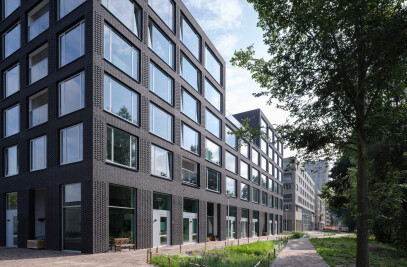The Langeveld building is one of the most sustainable educational buildings in the world with a BREEAM outstanding certificate. This building, designed by Paul de Ruiter Architects, is energy positive and runs on the wind, sun, and earth.

Powered by nature
Through a smart and integral design strategy, the new educational building is energy-positive. To achieve this, a revolutionary new natural ventilation principle has been applied, which runs on wind and solar energy. The two solar chimneys on the south façade create a vertical shaft in which the warm waist air will heat up even further creating an upward draft. On top of these shafts, a venturi roof, aircraft-winged shape, forces the wind to accelerate and therefore creates pressure sucking even harder on the solar chimneys. These forces pull fresh air into another vertical shaft. On top of this fresh air shaft, a cold-water shower forces the air to drop down in the shaft creating a constant fresh flow of air in the building. This naturally driven system uses 85% less energy than a traditional ventilation system while providing much more fresh air than is usual in buildings. This ensures a pleasant indoor climate for the multifunctional building. The heat in de summer gets stored in the deep earth to be used to heat in the winter, and in de winter, the cold gets stored in the earth to cool in summer. This long-term storage even further reduces energy. The solar cells on the roof make the building energy-positive.

Architecture meets nature
The building’s transparent facades create a natural connection with the surrounding campus and allow daylight to penetrate deep into the building. Lots of greenery and wooden detailing, including the atrium construction made of real wooden tree trunks, create a warm and pleasant experience and natural fresh air. A characteristic feature is the green study environment and the wooden tree house in the atrium. By using a biophilic design, nature is brought inside. This way the university is creating an environment that contributes to the well-being and health of the students.

Circular educational building
The new university building is circular in construction. This means that as much as possible recycled materials have been used. Demolition materials from other buildings are reused, and the material used are biobased. All the materials used in the new educational building have been given an identity which is recorded in a digital material passport. This passport will give insights into the future material potential for reuse. This has resulted in a BREEAM- outstanding certification. Only less than 1% of buildings in the Netherlands have this top qualification according to the world’s leading sustainability assessment method.

Team:
Client: Erasmus University Rotterdam
Project Architect: Paul de Ruiter
Project Team: Marieke Sijm, Matthijs Engele
Contractor: BAM Bouw& Techniek Projecten
Construction Consultant: BAM Advies en Engineering
Building Services Engineering: Halmos Adviseurs
Sustainability Consultant & Structural Engineering: LBP|Sight
Interior & loose furnishing: Marina van Goor
Landscape architect: Buro Harro Landschapsarchitect
Project Management: abcnova
Photographer: Aiste Rakauskaite








































